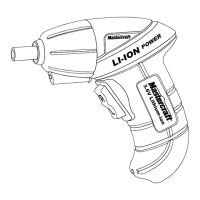PERSONAL SAFETY – continued
● Avoid accidental starting. Be sure
power switch is OFF before
plugging in. Carrying tools with finger
on the switch or plugging in tools that
have the switch ON invites accidents.
● Remove adjusting keys or wrenches
before turning the tool ON. A wrench
or key that is left attached to a rotating
or moving part of the tool may result in
personal injury.
● Do not overreach. Keep proper
footing and balance at all times.
Proper footing and balance enable
better control of the tool in unexpected
situations.
● Use safety equipment. Always wear
eye protection. Dust mask, non-skid
safety shoes, hard hat and/or hearing
protection must be used in appropriate
conditions.
TOOL USE AND CARE
● Use clamps or another practical
method to secure and support the
workpiece on a stable platform.
Holding the workpiece by hand or
against the body is unstable, unsafe,
and may lead to loss of control.
● Do not force the tool. Use the
correct tool for the required
application. The correct tool will do
the job better and safer at the rate for
which it is designed.
● Do not use the tool if the power
switch does not turn it ON or OFF.
Any tool that cannot be controlled by
the switch is dangerous and must be
repaired.
● Disconnect the plug from the power
source before making any
adjustments, changing accessories
or storing the tool. Such preventative
safety measures reduce the risk of the
tool starting accidentally.
● Store idle tools out of reach of
children and other untrained
persons. Tools are dangerous in the
hands of untrained users.
● Maintain tools with care. Keep
cutting tools sharp and clean.
Properly maintained cutting tools with
sharp cutting edges are less likely to
bind and are easier to control.
● Check for misalignment or binding
of moving parts, breakage of parts
and any other condition that may
affect the tool’s operation. If
damaged, have the tool serviced
before using. Numerous accidents
are caused by poorly maintained tools.
● Use only accessories that are
recommended by the manufacturer
for this model. Accessories that may
be suitable for one tool may be
hazardous when used with another
tool.

